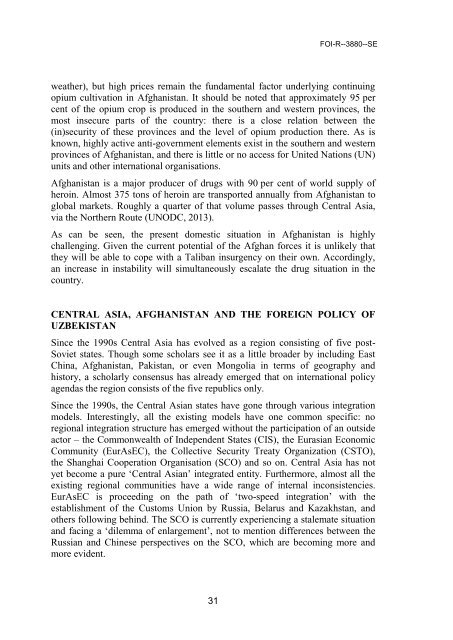foir_3880
foir_3880
foir_3880
You also want an ePaper? Increase the reach of your titles
YUMPU automatically turns print PDFs into web optimized ePapers that Google loves.
FOI-R--<strong>3880</strong>--SE<br />
weather), but high prices remain the fundamental factor underlying continuing<br />
opium cultivation in Afghanistan. It should be noted that approximately 95 per<br />
cent of the opium crop is produced in the southern and western provinces, the<br />
most insecure parts of the country: there is a close relation between the<br />
(in)security of these provinces and the level of opium production there. As is<br />
known, highly active anti-government elements exist in the southern and western<br />
provinces of Afghanistan, and there is little or no access for United Nations (UN)<br />
units and other international organisations.<br />
Afghanistan is a major producer of drugs with 90 per cent of world supply of<br />
heroin. Almost 375 tons of heroin are transported annually from Afghanistan to<br />
global markets. Roughly a quarter of that volume passes through Central Asia,<br />
via the Northern Route (UNODC, 2013).<br />
As can be seen, the present domestic situation in Afghanistan is highly<br />
challenging. Given the current potential of the Afghan forces it is unlikely that<br />
they will be able to cope with a Taliban insurgency on their own. Accordingly,<br />
an increase in instability will simultaneously escalate the drug situation in the<br />
country.<br />
CENTRAL ASIA, AFGHANISTAN AND THE FOREIGN POLICY OF<br />
UZBEKISTAN<br />
Since the 1990s Central Asia has evolved as a region consisting of five post-<br />
Soviet states. Though some scholars see it as a little broader by including East<br />
China, Afghanistan, Pakistan, or even Mongolia in terms of geography and<br />
history, a scholarly consensus has already emerged that on international policy<br />
agendas the region consists of the five republics only.<br />
Since the 1990s, the Central Asian states have gone through various integration<br />
models. Interestingly, all the existing models have one common specific: no<br />
regional integration structure has emerged without the participation of an outside<br />
actor – the Commonwealth of Independent States (CIS), the Eurasian Economic<br />
Community (EurAsEC), the Collective Security Treaty Organization (CSTO),<br />
the Shanghai Cooperation Organisation (SCO) and so on. Central Asia has not<br />
yet become a pure ‘Central Asian’ integrated entity. Furthermore, almost all the<br />
existing regional communities have a wide range of internal inconsistencies.<br />
EurAsEC is proceeding on the path of ‘two-speed integration’ with the<br />
establishment of the Customs Union by Russia, Belarus and Kazakhstan, and<br />
others following behind. The SCO is currently experiencing a stalemate situation<br />
and facing a ‘dilemma of enlargement’, not to mention differences between the<br />
Russian and Chinese perspectives on the SCO, which are becoming more and<br />
more evident.<br />
31


